Groundwater Quality Safety and Contamination Recovery
NANO-TITANIUM DIOXIDE MEDIATE PHOTOCATALYTIC DEGRADATION OF CAFFEINE
Shao Linlin, Yang shengke, Wang wenke
Environmental science and engineering College, Chang’an University,
Abstract:The effect conditions of the photocatalytic degradation of caffeine has been studied by using UV lamp as light-source and nano-TiO
Keywords: nano- TiO2,caffeine,photocatalytic,degradation
1 Introduction
In recent years, applications of semiconductor photocatalysts for the total destruction of organic compounds in polluted air and wastewaters have been one of most active areas in heterogeneous photocatalysis[1]. The use of TiO2 photocatalyst for environmental clean-up has been of great interest due to its non-toxic nature, photochemical stability and low lost when sunlight is used as the source of irradiation. When TiO2 is exposed to light of energy equal to or greater than the band gap energy (3.2ev for anatase TiO2),an electron is excited from the TiO2 valance band into the TiO2 surface where they initiate the redox reactions with organic species adsorbed on the surface. Many organic contaminants can be oxidized into CO2 and H2O and so on by UV/ TiO2[2-7].The aim of this study is to evaluate the effect conditions of photodecomposition caffeine in aqueous suspension of illuminated TiO2.Photodegradation kinetics was also studied and discussed in terms of Langmuir-hinshelwood model.
2 Material and Methods
2.1Material
UV-Visspectrophotometer(UV-2450,ShimadzuCorporation),quartzUVlamp(ZSZ-20,Beijing),magneticstirrer(QZD-1,chongqing),pHmeter(LP115,Mettler-Tolendo ),centrifuge(TGL
2.2Methods
In each experiments, the glass trough (245×195×
3 Result and Discussion
3.1The UV-VIS spectra of caffeine
The observed of UV spectra of caffeine under different concentrations of H2O2 is shown in Fig.1.The spectra of solution which only has caffeine shows two maximum absorption peak at206 and 207nm.As the solution is irradiated by UV lamp, the concentration of caffeine become diminution for nano- TiO2 photodecomposition. After the H2O2 is injected into the solution, the absorption spectra of caffeine has been varied, one is that absorption peak of 273nm disappeared while the concentration of H2O2 is raised; two is the 206 nm absorption peak gradual red-shift, the biggest red-shift reaches to 7 nm; three is that the adsorption spectral intensity of caffeine increases significantly when the H2O2 is joined into the solution , the spectral intensity become a direct proportion to the joining quantity of H2O2.Because when the H2O2 is joined into the solution, it bores abundantly hydroxyl radical(OH•) to impact the structure of caffeine, which lead to the absorption peak variation. Comparing curve 2 and curve 6 to find, two absorption peaks at206 and 207nm disappearance in the photodecomposition caffeine solution when the H2O2 is joined into the system, indicating that the decomposition of H2O2 and irradiation generating hydroxyl radical(OH•) is the main factor to cause the caffeine degradation .
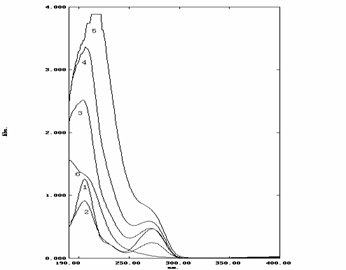
1—
3—
5—
Fig1.Absorption spectra of caffeine
3.2Effect conditions of the degradation of caffeine
Fig.2 shows the times courses of the photodecomposition of caffeine for different initial
concentrations with normalized concentration C/Co. Under certain conditions along the time variation, the caffeine is decomposed gradually ,the highest degradation rate is in 0-3h scope; the degradation rate is relative slowly exceed 3h;the lowest degradation rate is after 5h,so the irradiation time is selected 6h in the experiments. The degradation ratio of different initial concentration of caffeine indicated that the degradation rate of caffeine is relative highly as the initial concentration of caffeine ≤10mg/L,but as the initial concentration of caffeine≥10mg/L,the degradation ratio of caffeine is marked droply. Because the absorption catalyst is saturated in the high concentration of caffeine, the degradation ratio of caffeine isn’t controlled by the concentration of caffeine but to determine by the quantity of electron-hole pairs on the surface of TiO2.Electron-hole pairs generation is determined by the dosage of TiO2. Therefore when the dosage of TiO2 was definition ,the total photodecomposition of caffeine is relative stably, but the degradation ratio of caffeine is descended.
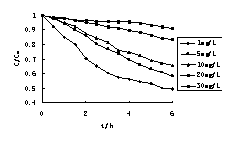
Fig2.Effect of irradiation time and the initial concentration
Figure 3 illustrates photodecomposition of 10 mg/L caffeine with the illumination of a UV lamp in the presence of different dosage of TiO2. The photodecomposition rates of caffeine was increased as the loading of TiO2 increasing from 0 to
photo-absorption of the catalyst. Adequate loading of TiO2 increases the generation rate of electron-hole pairs for promoting the degradation of caffeine and the absorption of TiO2 is also increased [8-9]. However, when the dose of TiO2 exceedes
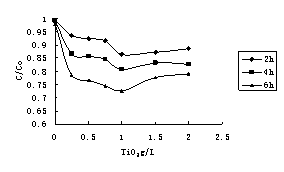
Fig,3 Effect of the dosage of nano-TiO2
Figure 4 illustrates the degradation of caffeine in TiO2/UV system under various pH values. The degradation rate of caffeine is the highest as 10.89 of pH. Because the pH of the aqueous solution influences the physicochemical properties of TiO2, including the charge on the particle, the aggregation number of particles, and the position of the conduction and valence band. The pH has a great effect on the photodecomposition efficiency of caffeine in presence of TiO2.TiO2 surface carries a net positive charge (pHzpc=6.25) at low pH value, while the caffeine and intermediates are primarily negatively and neutrally charged. Therefore, low pH values can facilitate the adsorption of the organic molecule and promote better photocatalytic degradation. But the degradation rate of caffeine is decreased when the pH is so low that the electron-hole pairs recombine easily. However better removal efficiency of caffeine in TiO2/UV system under alkali condition is found in our experiments. One possible explanation is that the photocatalytic transformation of caffeine does not involve hydroxyl radical (OH•) exclusively. Direct electron transfer and surface sorption reactions also contribute significantly to the disappearance of caffeine in TiO2 suspensions. Although there is no semiconductor exited in the solution of direct photolysis system, hydroxyl radical (OH•) and hydrated electrons can be formed when water is irradiation with high energy UV light[10-11]. Therefore, higher pH value can provide higher concentration of hydroxyl ions to react with holes to form hydroxyl radicals, subsequently enhancing the photodecomposition rate of caffeine. But the degradation ratio of caffeine is inhibited when the pH value is so high that hydroxyl ions compete with caffeine ions on the surface absorption of TiO2.
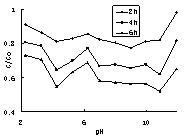
Fig4 Effect of pH value
H2O2 is added to enhance production of hydroxyl radical (OH•) through a series of redox reaction[1].Figure 5 shows the degradation ratio of caffeine is increased when the concentration of H2O2 increases from 0 to
H2O2+hv→2·OH
H2O2+e →·OH+
However H2O2 is a
reacting with the caffeine[].Moreover, as the rate of OH- generation increased, the reaction between OH- became faster; even faster than the rate of oxidation of the organic pollutants by OH-.As a result, the OH- were quenched by themselves and not available to oxidized the organize pollutants[12-13].
H2O2+·OH→H2O+·HO2
·HO2+·OH →H2O +O2

Fig.5 Effect of H2O2 concentration
3.3Kinetics of photocatalytic degradation of caffeine
The kinetics of caffeine degradation under the above conditions was stated by measuring the quantity of caffeine remaining in the solution as a function of UV irradiation time. The decrease in the concentration of caffeine could be accounted for by a Langmuir-Hinshelwood kinetic model[14-16]:
r=kθ= (1)
(1)
where r is the oxidation rate of the reactant,θthe surface coverge, C the concentration of the reactant, k the rate constant and K the equilibrium constant for the adsorption of the reactant. When the surface adsorption of catalyst is saturated in the high concentration of reactant, the rate of reactant is controlled by the quantity of electron-hole pairs, but the initial concentration has no effect on it. So the degradation react follows the zero-order decay kinetics. When the surface adsorption of isn’t saturated in the low concentration of reactant (KC«1), the rate of reactant is mainly controlled by the initial concentration of reagent, and the quantity of electron-hole pairs has some effect on it. So the degradation rate follows the first-order decay kinetics. Fig  ). Inversion of this rate expression provides a linear plot:
). Inversion of this rate expression provides a linear plot:  (2)
(2)
In fig 6b,the plot of reciprocal initial rates versus reciprocal initial caffeine concentrations is presented , with which are obtained the slope (kK)-1 and the intercept k-1.So the values of the rate constant k 0.1003mg/(L•min) and equilibrium absorption constant K
The basic assumption of the L-H kinetic model are that only one substrate may bind at each surface site and there is no interaction between adjacent adsorbed molecules[15].While in the photocatalytic reaction, three possible situations exist[16]:(ⅰ)adsorbed photoactive oxygen interacts with the reactant adsorbed or in solution; (ⅱ) hydroxyl groups and water molecules cover a TiO2 solid surface, they compete for the active sites of the catalyst; (ⅲ) substrate photodecomposes giving rise to intermediates competitively on the surface of catalyst. All these reflect in not ideal adsorption isotherms and mass transfer problems, so these reactions will require further study in detail. However ,the above mentioned behavior is mainly to recombination reactions of active species but not adsorption properties of the substrate, the use of Lanfmuir-Hinshelwood equation could provide reasonable simulations to the observed degradation kinetics since the behavior of the reaction rate versus reactant concentration could be adjusted to a mathematical expression with it.
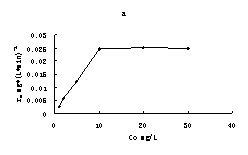
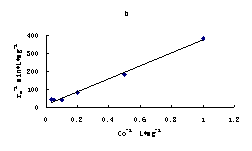
Fig
rates vs reciprocal initial concentrations
4 conclusion
(1) The optimum physicochemical conditions necessary for the degradation of caffeine were 10mg/L of caffeine,
(2)Photocatalytic degradation of caffeine follow first-order decay kinetics, calculating the degradation rate constant k 0.1003mg/(L•min) and absorption equilibrium constant K
Reference
[1] M.R.Hoffmann,S.T.Martin,W.Choi,etal, Environmental applications of semiconductor photocatalysis[J]. chem, Rev, 1995 95:69~96
[2] M.Muneer,J.Theurich,D.Bahnemann.Titanium dioxide mediated photocatalytiv degradation of 1,2-diethyl phthalate[J].Chemistry,2001,143:213-219.
[3] A.Bianco Prevot,E.Pramauro.Analytical monitoring of photocatalytic treatments Degradation of 2,3,6-trichlorobenzoic acid in aqueous TiO2 dispersions[J].Talanta,1999,48:847-857.
[4] B.Swarnalatha,Y.Anjaneyulu.Studies on the heterogeneous photocatalytic oxidation of 2,6-dinitrophenol in aqueous TiO2 suspension[J].Chem,2004,223:161-165.
[5] Michael L,Hitchman,Fang Tian.Studies of TiO2 thin films prepared by chemical vapour deposition for photocatalytic and photoelectrocatalytic degradation of 4-chlorophenol[J].Electroanalytical Cheml, 2002, 538: 165- 172.
[6] Chunmei Zhu,Liangyan Wang,,Linren Kong,et al.Photocatalytical degradation of Azo dyes by supported TiO2+UV in aqueous solution[J].Chemosphere,2000,41:303-309.
[7] Andjelka S,Topalov,Daniela V,et al.Photocatalytic activity of synth esized nanosized TiO2 toward the degradation of herbicide meloprop[J].Environ.2004,54:125-133.
[8] Ruey-an Doong,Chin-hua Chen,R.A.Maithreepala,etal. The influence of pH and Cadmium Sulfide on the photocatalytic degradation of 2-Chlorophenol in titanium dioxide suspension [J].Wat.Res.2001,35(12):2873-2880.
[9] Andjlka S.Topalov,Daniela V.Sojic,Dora A.Molnar-Gabor etal.Photocatalytic activity of synthesized nanosized TiO2 towards the degradation of herbicide mecoprop [J].Applied Catalysis B:Environmental 2004(54) 125-133.
[10] Wong C C,
A.Envison,Sci,Technol,2003,37:2310-2316.
[11] Balcioglu I A,Inel Y.Photocatalytic degradation of organic contaminants in semiconductor suspicions with added H2O2[J].J.Environ.Sci.Health,1996,13:123-138.
[12] So C M,Cheng M Y,Yu J C,et al.Degradation of azo dye procion red MX-5B by photocatalytic oxidation[J].Chemosphere,2002,46:905-912.
[13] Zhang Y,Crittenden J C,Hand D W,et al.Fixed-Bad Photocatalysts for solar Decontamination of water [J].Environ.Sci.Technol.1994,28(3):435-442.
[14] G.Siva Lingam,M.H.Priya,Giridhar Madras.Kinetics of the photodegradation of Substituted phenols by solution combustion synthesized [J].Applied Catzlysis B:Environmental 2004,51:67-76.
[15] Xin-hua Qi,Zhong-hua Wang,Yuan-yi Zhang etal.Study on the photocatasis performance and degradation kinetics of X-3B over modified titanium dioxide[J].Journal of Hazardous Materials B118,2005:219-225.
[16] Xinle Zhu,Xiaogang Feng,Chunwei Yuan,etal.Photocatalytic degradation of pesticide pyridaben in suspension of TiO2: identification of intermediates and degradation pathways [J].Journal of Molecular Catalysis A: Chemical 2004 (214) 293-300.




